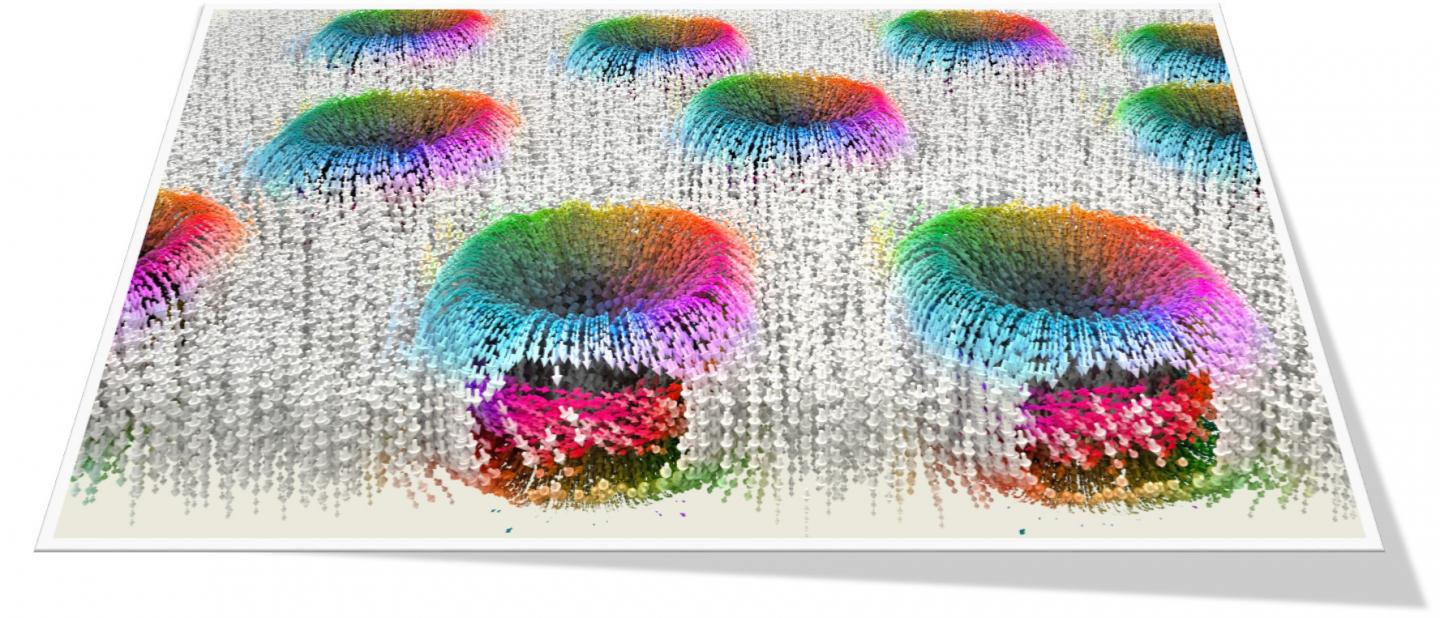Author:
U.S. Army Research Laboratory
Date
05/10/2019

Army funded research discovery may allow for development of novel device structures that can be used to improve logic/memory, sensing, communications, and other applications for the Army as well as industry. Image demonstrates simulation of emergent chirality in polar skyrmions for the first time in oxide superlattices
RESEARCH TRIANGLE PARK, N.C. - Research funded in part by the U.S. Army identified properties in materials that could one day lead to applications such as more powerful data storage devices that continue to hold information even after a device has been powered off.
A team of researchers led by Cornell University and the University of California Berkeley made a discovery that opens up a plethora of materials systems and physical phenomena that can now be explored.
The scientists observed what's known as chirality for the first time in polar skyrmions in an exquisitely designed and synthesized artificial material with reversible electrical properties. Chirality is where two objects, like a pair of gloves, can be mirror images of each other but cannot be superimposed on one another. Polar skyrmions are textures made up of opposite electric charges known as dipoles.
Researchers had always assumed that skyrmions would only appear in magnetic materials, where special interactions between magnetic spins of charged electrons stabilize the twisting chiral patterns of skyrmions. When the team discovered skyrmions in an electric material, they were astounded, they said.
The combination of polar skyrmions and these electrical properties may allow for the development of novel devices that are of significant interest to the Army, especially using the chirality as a parameter that can be manipulated.
"Now that we know that polar/electric skyrmions are chiral, we want to see if we can electrically manipulate them," said Dr. Ramamoorthy Ramesh, the co-principal investigator of this project. "If I apply an electric field, can I turn each one like a turnstile? Can I move each one, one at a time, like a checker on a checkerboard? If we can somehow move them, write them, and erase them for data storage, then that would be an amazing new technology."
Researchers published their findings in the journal Nature.
"This ground-breaking discovery can be used in the future to develop device structures that can be used to improve logic/memory, sensing, communications, and other applications for the Army as well as industry," said Dr. Pani (Chakrapani) Varanasi, chief of the Materials Science Division of the Army Research Office, an element of U.S. Army Combat Capabilities Command's Army Research Laboratory.
When the team began the study in 2016, they had set out to find ways to control how heat moves through materials. They fabricated a special crystal structure called a superlattice from alternating layers of lead titanate (an electrically polar material, whereby one end is positively charged and the opposite end is negatively charged) and strontium titanate (an insulator, or a material that doesn't conduct electric current).
The research team started to explore the synthesis of artificially designed and structured oxides, with the goal to explore emergent phenomena. Emergent phenomena are pervasive in nature - fish swimming in a school, birds flying in formation, the emergence of crowd and mobs are all examples of how interactions of discrete objects (fish, birds, humans) can lead to unexpected collective behavior. Materials can also exhibit such emergent behavior, especially when placed under constraints.
When the scientists took scanning transmission electron microscopy measurements of the artificially engineered lead titanate/strontium titanate superlattice, they saw something strange that had nothing to do with heat: Bubble-like formations had cropped up all across the material. Lead titanate is a well-known ferroelectric material, while strontium titanate, its sister compound is not ferroelectric at room temperature. Ferroelectric are materials that have a spontaneous electric polarization that can be reversed by the application of an external electric field.
Those bubbles, it turns out, were polar skyrmions.
While using sophisticated scanning transmission electron microscopy at Berkeley Lab's Molecular Foundry and at the Cornell Center for Materials Research, David Muller of Cornell University took atomic snapshots of skyrmions' chirality at room temperature in real time. The researchers discovered that the forces placed on the polar lead titanate layer by the nonpolar strontium titanate layer generated the polar skyrmion bubbles in the lead titanate.
"Materials are like people," Ramesh said. "When people get stressed, they respond in unpredictable ways. And that's what materials do too: In this case, by surrounding lead titanate by strontium titanate, lead titanate starts to go crazy - and one way that it goes crazy is to create polar textures like skyrmions instead of being uniformly polarized."
"This work has enabled the discovery of a fundamentally new phenomena in oxide superlattices," Schlom said. "We now have a template based on epitaxy to create many other science universes. For example, we can start to look at spin-charge coupling in such superlattices; work on this is already underway."
The researchers also plan to study the effects of applying an electric field on the polar skyrmions.
EurekAlert!, the online, global news service operated by AAAS, the science society: https://www.eurekalert.org/pub_releases/2019-05/uarl-dml050919.php